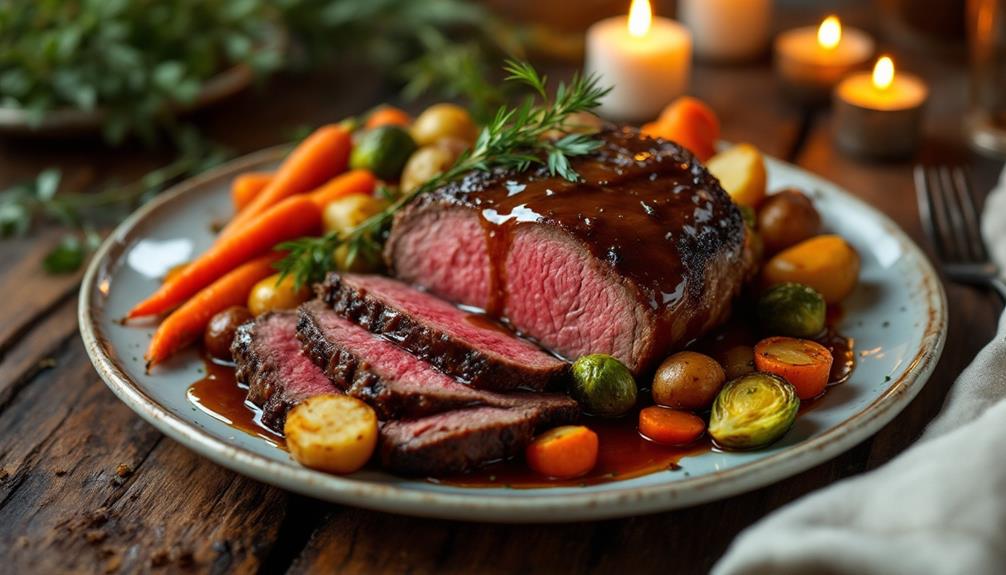You might think that preparing a traditional beef roast is too complicated, but it doesn't have to be. With the right cut and some essential seasoning techniques, you can create a dish that's both impressive and satisfying. Understanding the different cooking methods can elevate your roast to a new level, and pairing it with classic side dishes will round out your meal beautifully. What's more, knowing how to handle leftovers can add even more value to your efforts. Let's explore the key elements that make a beef roast not just a meal, but a memorable experience.
Key Takeaways
- Choose a cut like chuck roast or ribeye for a flavorful and tender traditional beef roast experience.
- Season generously with salt, pepper, and herbs like rosemary and thyme for enhanced flavor.
- Use the roasting method, searing the meat on the stovetop before finishing in the oven for optimal juiciness.
- Pair your roast with classic sides like garlic mashed potatoes and roasted vegetables for a complete meal.
- Store leftovers properly and reheat gently to enjoy delicious meals throughout the week.
Choosing the Right Cut
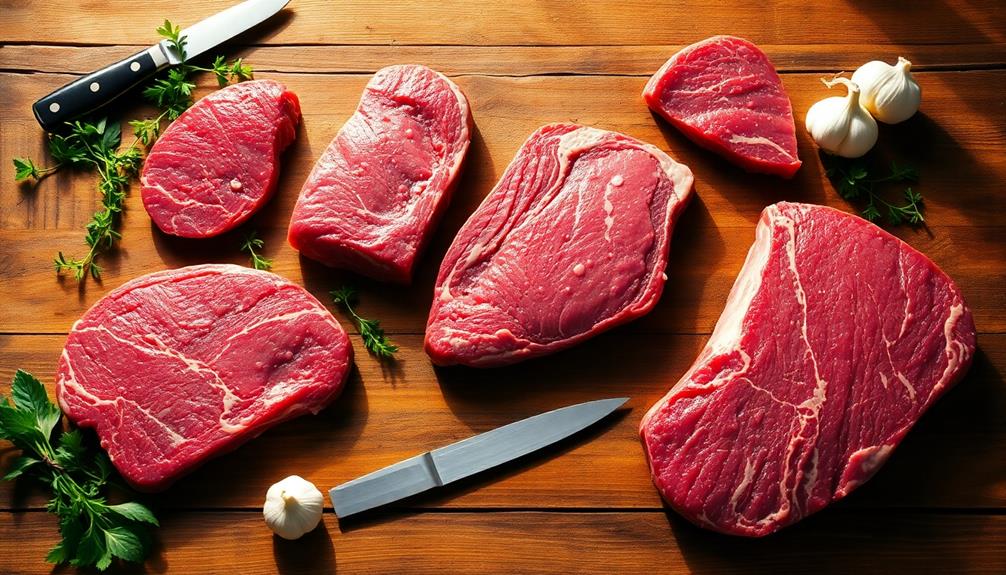
When it comes to choosing the right cut for your beef roast, understanding the various options available will make all the difference. You'll want to consider factors like tenderness, flavor, and cooking method. For a classic roast, chuck roast is a great choice. It's affordable, flavorful, and becomes tender when slow-cooked, making it perfect for pot roasts.
If you're looking for something more upscale, tenderloin is an excellent option. It's incredibly tender and lean, ideal for special occasions, but it can be pricier. Ribeye roast is another fantastic choice, known for its rich marbling, which adds flavor and juiciness. It's perfect for those who enjoy a more decadent meal.
For a robust flavor, consider a brisket. While it requires longer cooking times, the result is a mouthwatering, melt-in-your-mouth experience. Lastly, the eye of round is a lean cut that works well for roasting, but you'll need to be cautious with cooking time to avoid dryness.
Essential Seasoning Techniques
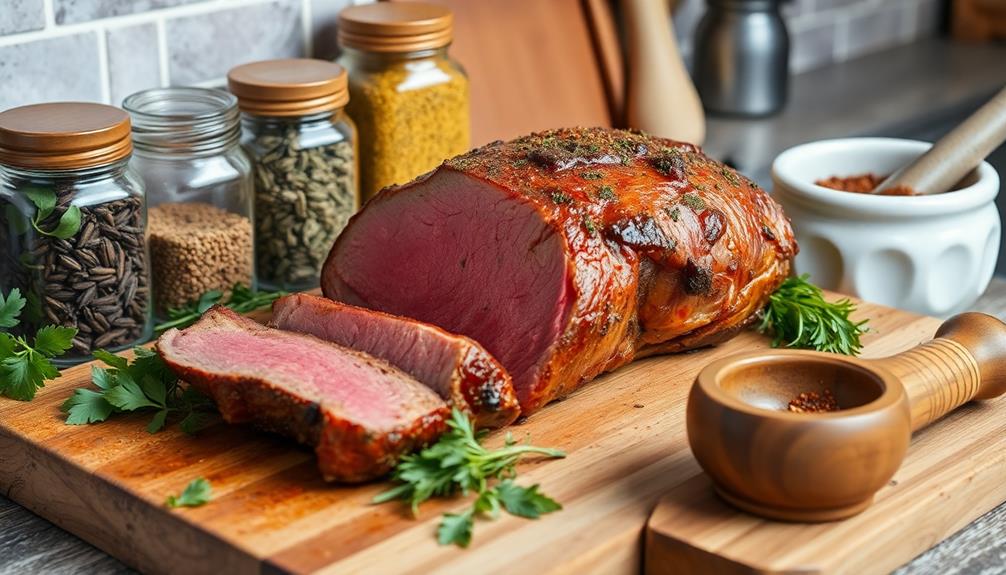
Seasoning your beef roast properly is key to elevating its flavor and ensuring a delicious meal. Start by choosing a good blend of salt and pepper as your base. Salt enhances the natural flavors, while pepper adds a subtle kick. Don't skimp on the seasoning; a generous amount will create a flavorful crust.
Next, consider using garlic and onion powder for added depth, or fresh herbs like rosemary, thyme, and parsley for a fragrant touch. Rub these seasonings directly onto the roast, making sure to cover all sides. For even better results, try marinating your beef with these herbs, along with olive oil and a splash of vinegar, a few hours or overnight before cooking.
If you're feeling adventurous, explore other spices like smoked paprika, cumin, or even a dash of cayenne for a bit of heat. These can bring unique flavors to your roast, making it stand out.
Lastly, remember to season according to the size of your cut. A larger roast requires more seasoning to ensure every bite is flavorful. With these essential seasoning techniques, you're well on your way to crafting a mouthwatering beef roast.
Cooking Methods Explained
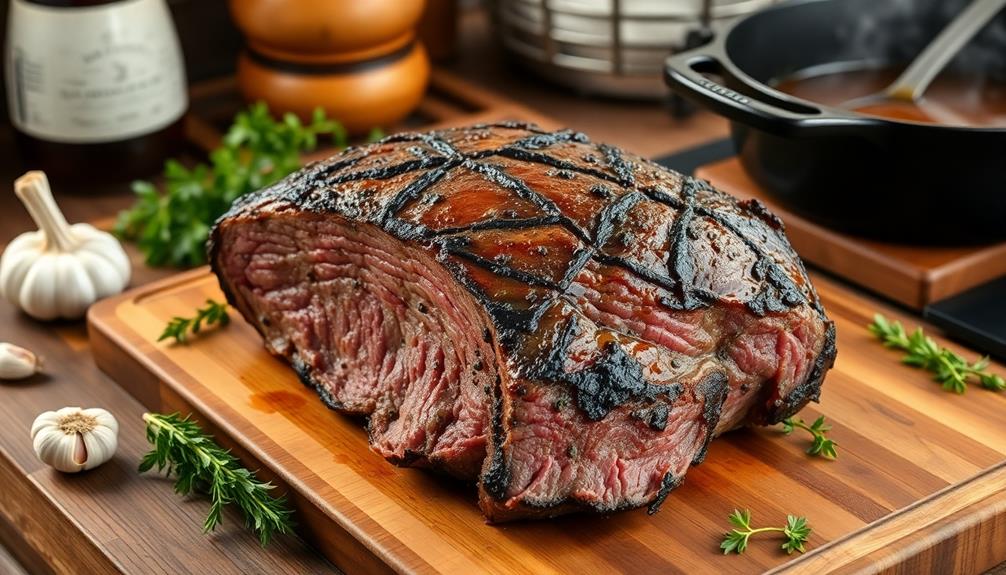
Once you've mastered the art of seasoning your beef roast, the next step is to choose the right cooking method to bring out those flavors. There are several methods you can use, each offering a unique texture and taste to your roast.
Roasting is the most traditional method. It involves cooking the beef in an oven, allowing the exterior to caramelize while keeping the interior juicy. For best results, sear the roast on the stovetop before placing it in the oven.
If you're short on time, consider using a slow cooker. This method allows for low and slow cooking, perfect for tougher cuts of beef, resulting in tender, flavorful meat. Just season, set the cooker, and let it work its magic.
Another method is braising, where you first sear the beef and then cook it in a covered pot with liquid. This combines dry and moist heat, breaking down tough fibers for a melt-in-your-mouth experience.
Lastly, sous vide is gaining popularity. By vacuum-sealing the meat and cooking it in a water bath at a precise temperature, you ensure evenly cooked, tender roast every time. Choose the method that fits your schedule and enjoy the delicious results!
Classic Side Dishes
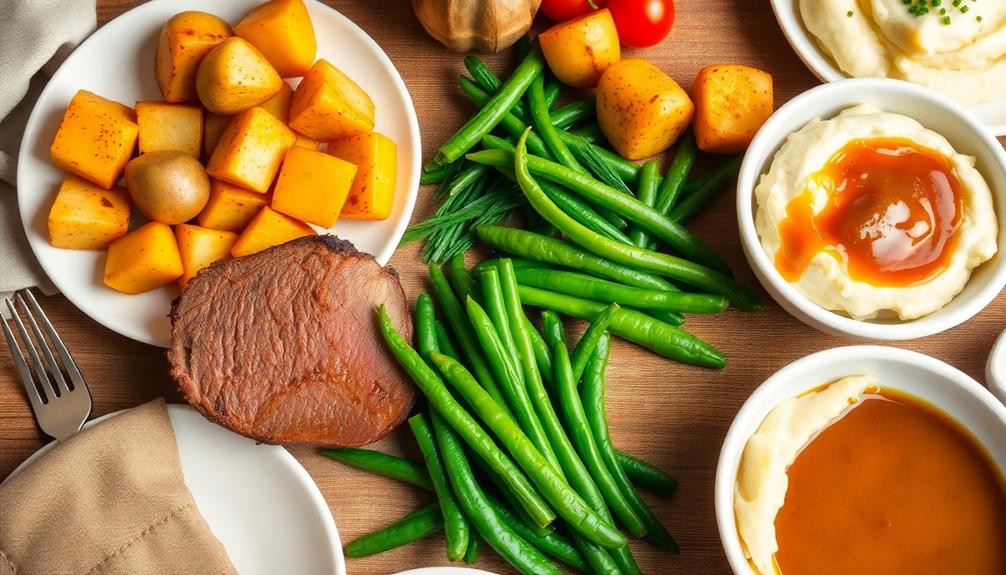
Classic side dishes can elevate your beef roast to a whole new level. Pairing your roast with the right sides not only complements the flavors but also enhances the overall dining experience. Here are three classic side dishes you should consider:
- Garlic Mashed Potatoes: Creamy and buttery, garlic mashed potatoes are a timeless choice. Their rich texture and flavor perfectly balance the savory notes of your roast.
- Roasted Vegetables: A mix of seasonal vegetables, such as carrots, Brussels sprouts, and potatoes, roasted until caramelized, adds a delightful crunch and vibrant color to your plate. They absorb the juices from the roast, creating a harmonious blend of flavors.
- Yorkshire Pudding: This traditional British side is a must-try. Light and airy, Yorkshire pudding is perfect for soaking up gravy, making each bite even more satisfying.
Tips for Perfect Leftovers
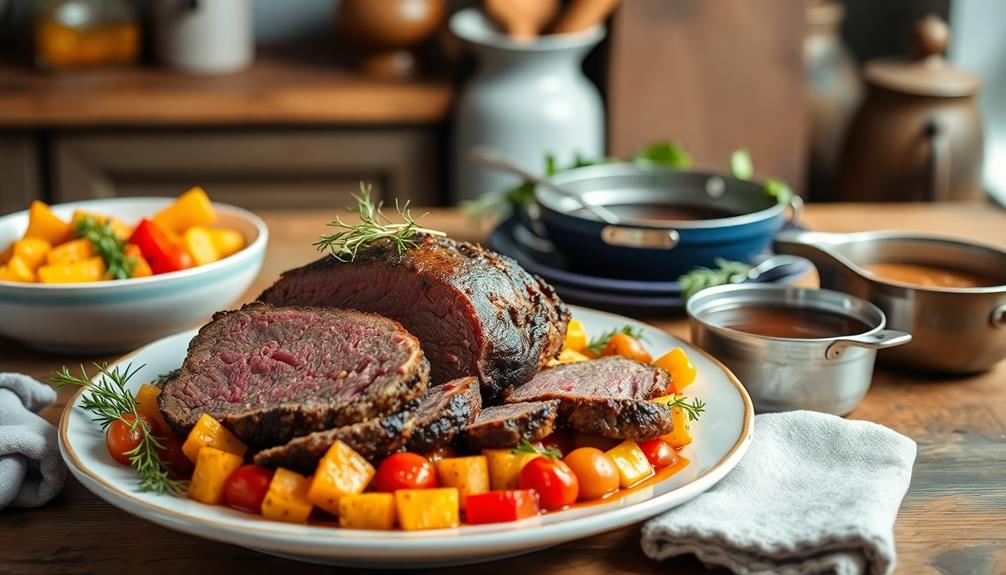
After enjoying a delicious beef roast, you might find yourself with some tasty leftovers that deserve just as much attention. To keep those flavors intact, store your leftovers properly. First, let the roast cool down to room temperature, but don't leave it out for more than two hours to avoid bacteria growth. Slice the beef into smaller portions, which not only makes reheating easier but also helps it cool quicker.
Next, wrap the beef tightly in plastic wrap or aluminum foil, or seal it in an airtight container. This prevents the meat from drying out and keeps it fresh for up to four days in the fridge. If you're not planning to eat it soon, consider freezing it. Just make sure to label the container with the date.
When you're ready to enjoy those leftovers, gently reheat the beef in the oven at a low temperature to preserve its moisture. You can also add a splash of broth to keep it juicy. If you're feeling creative, use the beef in sandwiches, salads, or stir-fries for a delicious twist. Enjoy turning those leftovers into something special!
Frequently Asked Questions
What Wine Pairs Best With Traditional Beef Roast?
When you're choosing a wine to pair with beef roast, consider a full-bodied red like Cabernet Sauvignon or Merlot. Their rich flavors complement the meat, enhancing your dining experience beautifully. Enjoy your meal!
How Long Should Beef Roast Rest Before Slicing?
You should let your beef roast rest for at least 15 to 20 minutes before slicing. This allows the juices to redistribute, ensuring a juicier and more flavorful result when you finally cut into it.
Can I Use Frozen Beef Roast?
Sure, you can use frozen beef roast! Just remember, thawing it might take longer than cooking it. You'll get a tender, juicy meal eventually, but patience isn't often a cook's best friend, right?
What Are the Best Herbs for Beef Roast?
When seasoning your beef roast, thyme, rosemary, and garlic are excellent choices. They enhance the flavor beautifully. Don't forget to add some black pepper and salt for a well-rounded taste that elevates your dish!
How Do I Know When the Roast Is Done?
Think of your roast as a symphony; each note matters. To know it's done, use a meat thermometer. Aim for 130°F for medium-rare. Let it rest before serving, letting flavors harmonize beautifully.
Conclusion
In the end, crafting a traditional beef roast is like riding a bicycle—once you've got the basics down, it's easy to make it your own. By choosing the right cut, mastering essential seasonings, and picking the perfect cooking method, you'll create a dish that brings everyone to the table. Don't forget those classic sides to round out the meal! And when it's all said and done, your leftovers will be just as delightful the next day.
